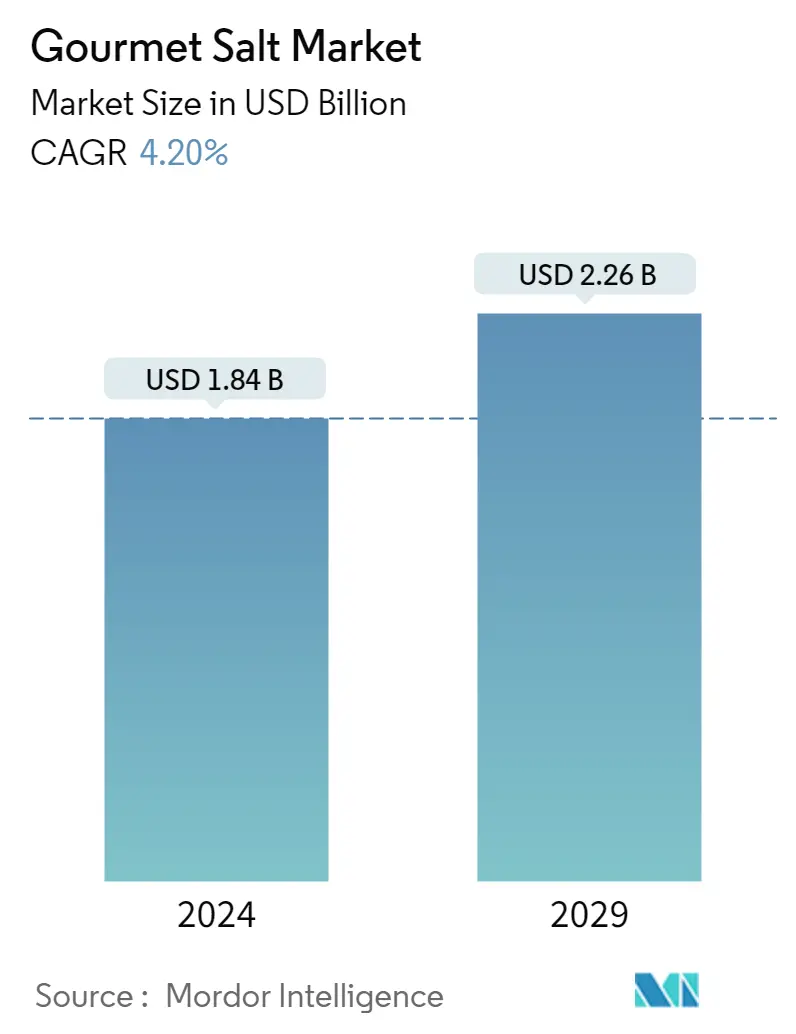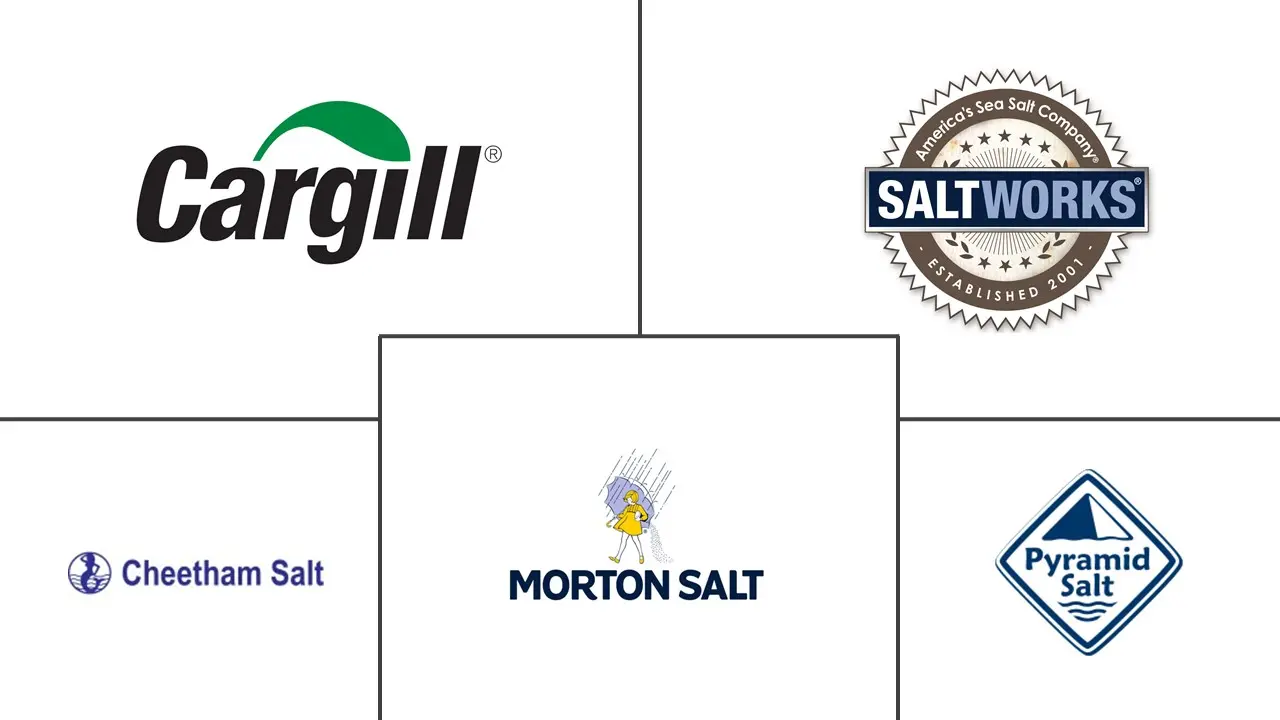Market Size of Gourmet Salt Industry

| Study Period | 2019 - 2029 |
| Market Size (2024) | USD 1.84 Billion |
| Market Size (2029) | USD 2.26 Billion |
| CAGR (2024 - 2029) | 4.20 % |
| Fastest Growing Market | Asia Pacific |
| Largest Market | Europe |
Major Players
*Disclaimer: Major Players sorted in no particular order |
Gourmet Salt Market Analysis
The Gourmet Salt Market size is estimated at USD 1.84 billion in 2024, and is expected to reach USD 2.26 billion by 2029, growing at a CAGR of 4.20% during the forecast period (2024-2029).
The COVID-19 pandemic has boosted the demand for food and food supplements that are healthy and those consisting of several nutrition and minerals. As it is observed that patients with hypertension, cardiovascular diseases were highly affected by COVID-19. Therefore, demand for products such as gourmet salts which consist of a lower amount of sodium has increased. Also, as consumers make lifestyle changes such as the shift toward organic and natural food, in their diets, thus the application for gourmet salts has further increased in the various final food products. For instance, according to Cornish Sea Salt Co., the demand for sea salt has raised significantly in the United Kingdom, due to the organic nature of the product which avails 60% of sea minerals to the consumer in 2020.
The cosmopolitan culture has created a demand for traditional cuisines in the metros, and this has subsequently led to the increased application of gourmet salts. This is because its particular flavor can incorporate a ting of traditional flavor and aroma in foods. These salts have also gained popularity among professional chefs in luxury hotels. The increase in the number of gourmet restaurants globally is positively influencing the gourmet salt market.
Gourmet Salt Industry Segmentation
Gourmet salts are unrefined, naturally harvested salts (generally sea salts) with relatively lesser sodium content, and without additives. The global gourmet salt market is segmented by type application and geography. By product type, the market is segmented into sel gris, flakey salt, Himalayan salt, fleur de sel, specialty salt, and other product types. By application, the market is segmented into confectionery, bakery, meat and poultry, seafood, sauces and savories, and other applications. By geography, the gourmet salt market is segmented into North America, Europe, Asia-Pacific, South America, and Middle-East and Africa. For each segment, the market sizing and forecasting have been done in value terms (USD million).
| By Type | |
| Sel Gris | |
| Flakey Salt | |
| Himalayan Salt | |
| Fleur de sel | |
| Specialty Salt | |
| Other Types |
| By Application | |
| Confectionary | |
| Bakery | |
| Meat and Poultry | |
| Sea Food | |
| Sauces and Savories | |
| Other Applications |
| By Geography | |||||||||
| |||||||||
| |||||||||
| |||||||||
| |||||||||
|
Gourmet Salt Market Size Summary
The gourmet salt market is experiencing a notable expansion, driven by shifting consumer preferences towards healthier and more natural food options. The COVID-19 pandemic has accelerated this trend, as individuals increasingly seek products with lower sodium content to mitigate health risks associated with conditions like hypertension and cardiovascular diseases. This shift is further supported by a growing inclination towards organic and natural foods, which has enhanced the application of gourmet salts in various culinary products. The cosmopolitan culture and the rising popularity of traditional cuisines in urban areas have also contributed to the demand for gourmet salts, as they add unique flavors and aromas to dishes. The foodservice industry, particularly gourmet restaurants, is witnessing growth due to globalization and the increasing popularity of foreign cuisines, further boosting the demand for gourmet salts as essential ingredients in luxury dining experiences.
Regionally, Europe leads the gourmet salt market, with consumers increasingly transitioning from regular table salt to gourmet varieties due to their perceived health benefits, such as reduced sodium content. This shift is particularly pronounced given the high prevalence of cardiovascular diseases in the region, prompting a greater focus on health-conscious dietary choices. The market is characterized by intense competition, with both domestic and international players like Cargill Inc. and Morton Salt Inc. leveraging advanced technologies and strategic acquisitions to enhance production capabilities and market presence. Innovations such as Cargill's new purified sea salt flour and SaltWorks' B2B eCommerce tools exemplify the industry's focus on meeting diverse consumer needs and driving sales growth. The gourmet salt market is poised for continued growth, supported by evolving consumer tastes and the increasing application of gourmet salts in various food processing sectors.
Gourmet Salt Market Size - Table of Contents
-
1. MARKET DYNAMICS
-
1.1 Market Drivers
-
1.2 Market Restraints
-
1.3 Porter's Five Forces Analysis
-
1.3.1 Threat of New Entrants
-
1.3.2 Bargaining Power of Buyers/Consumers
-
1.3.3 Bargaining Power of Suppliers
-
1.3.4 Threat of Substitute Products
-
1.3.5 Intensity of Competitive Rivalry
-
-
-
2. MARKET SEGMENTATION
-
2.1 By Type
-
2.1.1 Sel Gris
-
2.1.2 Flakey Salt
-
2.1.3 Himalayan Salt
-
2.1.4 Fleur de sel
-
2.1.5 Specialty Salt
-
2.1.6 Other Types
-
-
2.2 By Application
-
2.2.1 Confectionary
-
2.2.2 Bakery
-
2.2.3 Meat and Poultry
-
2.2.4 Sea Food
-
2.2.5 Sauces and Savories
-
2.2.6 Other Applications
-
-
2.3 By Geography
-
2.3.1 North America
-
2.3.1.1 United States
-
2.3.1.2 Canada
-
2.3.1.3 Mexico
-
2.3.1.4 Rest of North America
-
-
2.3.2 Europe
-
2.3.2.1 United Kingdom
-
2.3.2.2 Germany
-
2.3.2.3 France
-
2.3.2.4 Russia
-
2.3.2.5 Italy
-
2.3.2.6 Spain
-
2.3.2.7 Rest of Europe
-
-
2.3.3 Asia-Pacific
-
2.3.3.1 India
-
2.3.3.2 China
-
2.3.3.3 Japan
-
2.3.3.4 Australia
-
2.3.3.5 Rest of Asia-Pacific
-
-
2.3.4 South America
-
2.3.4.1 Brazil
-
2.3.4.2 Argentina
-
2.3.4.3 Rest of South America
-
-
2.3.5 Middle-East and Africa
-
2.3.5.1 South Africa
-
2.3.5.2 United Arab Emirates
-
2.3.5.3 Rest of Middle-East and Africa
-
-
-
Gourmet Salt Market Size FAQs
How big is the Gourmet Salt Market?
The Gourmet Salt Market size is expected to reach USD 1.84 billion in 2024 and grow at a CAGR of 4.20% to reach USD 2.26 billion by 2029.
What is the current Gourmet Salt Market size?
In 2024, the Gourmet Salt Market size is expected to reach USD 1.84 billion.

